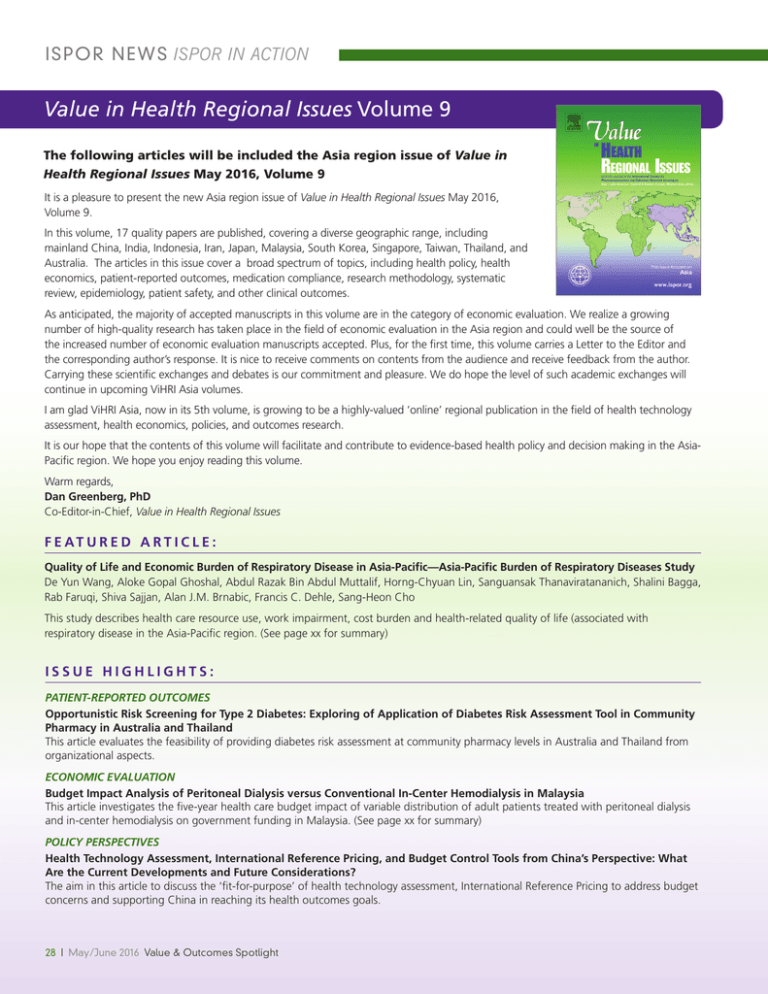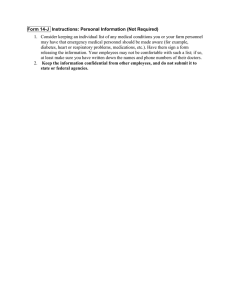Value in Health Regional Issues Volume 9
advertisement

ISPOR N Ew S ISPOR IN ACTION Value in Health Regional Issues Volume 9 The following articles will be included the Asia region issue of Value in Health Regional Issues May 2016, Volume 9 It is a pleasure to present the new Asia region issue of Value in Health Regional Issues May 2016, Volume 9. In this volume, 17 quality papers are published, covering a diverse geographic range, including mainland China, India, Indonesia, Iran, Japan, Malaysia, South Korea, Singapore, Taiwan, Thailand, and Australia. The articles in this issue cover a broad spectrum of topics, including health policy, health economics, patient-reported outcomes, medication compliance, research methodology, systematic review, epidemiology, patient safety, and other clinical outcomes. As anticipated, the majority of accepted manuscripts in this volume are in the category of economic evaluation. We realize a growing number of high-quality research has taken place in the field of economic evaluation in the Asia region and could well be the source of the increased number of economic evaluation manuscripts accepted. Plus, for the first time, this volume carries a Letter to the Editor and the corresponding author’s response. It is nice to receive comments on contents from the audience and receive feedback from the author. Carrying these scientific exchanges and debates is our commitment and pleasure. We do hope the level of such academic exchanges will continue in upcoming ViHRI Asia volumes. I am glad ViHRI Asia, now in its 5th volume, is growing to be a highly-valued ‘online’ regional publication in the field of health technology assessment, health economics, policies, and outcomes research. It is our hope that the contents of this volume will facilitate and contribute to evidence-based health policy and decision making in the AsiaPacific region. We hope you enjoy reading this volume. Warm regards, Dan Greenberg, PhD Co-Editor-in-Chief, Value in Health Regional Issues F E AT U R E D ARTI C L E : Quality of Life and Economic Burden of Respiratory Disease in Asia-Pacific—Asia-Pacific Burden of Respiratory Diseases Study De Yun Wang, Aloke Gopal Ghoshal, Abdul Razak Bin Abdul Muttalif, Horng-Chyuan Lin, Sanguansak Thanaviratananich, Shalini Bagga, Rab Faruqi, Shiva Sajjan, Alan J.M. Brnabic, Francis C. Dehle, Sang-Heon Cho This study describes health care resource use, work impairment, cost burden and health-related quality of life (associated with respiratory disease in the Asia-Pacific region. (See page xx for summary) ISS U E H I G H LI G H TS : Patient-Reported Outcomes Opportunistic Risk Screening for Type 2 Diabetes: Exploring of Application of Diabetes Risk Assessment Tool in Community Pharmacy in Australia and Thailand This article evaluates the feasibility of providing diabetes risk assessment at community pharmacy levels in Australia and Thailand from organizational aspects. Economic Evaluation Budget Impact Analysis of Peritoneal Dialysis versus Conventional In-Center Hemodialysis in Malaysia This article investigates the five-year health care budget impact of variable distribution of adult patients treated with peritoneal dialysis and in-center hemodialysis on government funding in Malaysia. (See page xx for summary) Policy Perspectives Health Technology Assessment, International Reference Pricing, and Budget Control Tools from China’s Perspective: What Are the Current Developments and Future Considerations? The aim in this article to discuss the ‘fit-for-purpose’ of health technology assessment, International Reference Pricing to address budget concerns and supporting China in reaching its health outcomes goals. 28 | May/June 2016 Value & Outcomes Spotlight ISPOR NEwS ISPOR IN ACTION M OR E ISS U E H I G H LI G H TS : Preference-Based Assessments Utilities for Type 2 Diabetes Treatment-Related Attributes in a South Korean and Taiwanese Population This article elicits utilities associated with type 2 diabetes medication-related attributes from South Korean and Taiwanese populations and to identify key drivers of preferences. (See below for summary) Methodological Value of Information in Asia: Concepts, Current Use, and Future Directions This article enables health economists, outcomes researchers, and policy makers in Asia to better understand the importance of value of information analysis and its implications, leading to its appropriate use in Asia. Comparative Effectiveness Research/Health Technology Assessment Comparison of Healthcare Utilization and Costs for Patients with Asthma by Severity and Health Insurance in Thailand This article compares health care utilization and cost by asthma severity and type of health insurance in Thailand. For all articles in this issue, or to submit an article, see: http://www.ispor.org/publications/VIHRI/index.asp. Spotlight on Value in Health Regional Issues From Volume 9 (May 2016): ECONOMIC EVALUATION Quality of Life and Economic Burden of Respiratory Disease in Asia-Pacific—Asia-Pacific Burden of Respiratory Diseases (APBORD) Study (pp. 72–77) De Yun Wang, Aloke Gopal Ghoshal, Abdul Razak Bin Abdul Muttalif, Horng-Chyuan Lin, Sanguansak Thanaviratananich, Shalini Bagga, Rab Faruqi , Shiva Sajjan, Alan J.M. Brnabic, Francis C. Dehle, and Sang-Heon Cho The authors present a cross-sectional, observational study that examines the burden of disease in adults with respiratory diseases across six countries. The aim of this study was to describe health care resource use (HCRU), work impairment, cost burden, and health-related quality of life (HRQoL) associated with respiratory disease in the Asia-Pacific region. The study enrolled 5,250 consecutive participants aged 18 years or older with a primary diagnosis of asthma, allergic rhinitis, chronic obstructive pulmonary disease, or rhinosinusitis. Participants completed a survey detailing respiratory symptoms, HCRU, work productivity and activity impairment, and HRQoL. Overall, the mean annual cost for patients with a respiratory disease was US $4,191 (SGD 8489) per patient. For patients who reported impairment at work, the mean annual cost was US $7,315 (SGD 10,244), with productivity loss being the highest cost component for all four diseases (US $6,310 [SGD 9100]). Timely and effective management of respiratory diseases has the potential to reduce disease burden and health care costs and improve work productivity and HRQoL. Budget Impact Analysis of Peritoneal Dialysis versus Conventional In-Center Hemodialysis in Malaysia (pp. 8–14) Sunita Bavanandan, Ghazali Ahmad, Ai-Hong Teo, Lilian Chen, Frank Xiaoqing Liu This study investigates a five-year health care budget impact of various distributions of adult patients treated with peritoneal dialysis (PD) versus in-center hemodialysis (ICHD) on government funding for dialysis treatment in Malaysia. Using an Excel®-based budget impact model, increasing the utilization of PD was estimated to generate substantial cost savings for the Malaysian government. This information is important in view of the pressing need for cost containment and sustainable dialysis plans in the face of burgeoning numbers of patients with chronic kidney disease in the country. A PD preferred policy for clinically appropriate patients in the setting of an integrated dialysis approach might also be a good strategy to address inequity in dialysis access. PREFERENCE-BASED ASSESSMENTS Utilities for Type 2 Diabetes Treatment-Related Attributes in a South Korean and Taiwanese Population (pp. 67–71) Narayan Rajan, Kristina S. Boye, Meaghan Gibbs, Yoon Ji Lee, Peter Davey, Mark Ball, Steve M. Babineaux In order to understand the effect that diabetes treatments have on patients’ well-being, the study elicited utilities associated with type 2 diabetes medications-related attributes from South Korea and Taiwan populations. The results showed that mean utility for basic health state was 0.75 and respondents showed a preference for weekly over daily administration (average increase in utility of 0.043 across all health states with weekly vs daily administration). Treatment-related attributes, in particular dose frequency and the potential for nausea, had a measurable effect on utility and should be considered when selecting treatment regimens for South Korean/Taiwanese patients with type 2 diabetes. Value & Outcomes Spotlight May/June 2016 | 29
